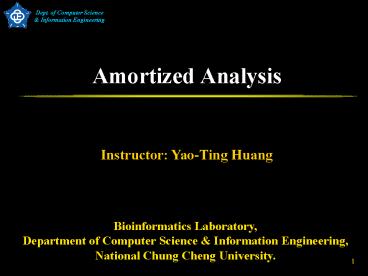Amortized Analysis - PowerPoint PPT Presentation
1 / 24
Title:
Amortized Analysis
Description:
Amortized analysis guarantees the average performance of each operation in the worst case. ... The total amortized cost of a sequence of operations must be an ... – PowerPoint PPT presentation
Number of Views:487
Avg rating:3.0/5.0
Title: Amortized Analysis
1
Amortized Analysis
Instructor Yao-Ting Huang
Bioinformatics Laboratory, Department of Computer
Science Information Engineering, National Chung
Cheng University.
2
Amortized Analysis
- The time required to perform a sequence of
operations in average over all the operations
performed. - Amortized analysis guarantees the average
performance of each operation in the worst case. - It differs from average-case analysis in that
probability is not involved.
3
Analyzing Quicksort Average Case
- So partition generates splits (0n-1, 1n-2,
2n-3, , n-21, n-10) each with probability
1/n. - If T(n) is the expected running time,
4
Randomized Selection
- Average case
- For upper bound, assume ith element always falls
in larger side of partition
5
Intuition
- For all n, a sequence of n operations takes worst
time T(n) in total. The amortize cost of each
operation is .
6
The aggregate analysis
- Stack operation
- - PUSH(S, x)
- - POP(S)
- - MULTIPOP(S, k)
- MULTIPOP(S, k)
- 1 while not STACK-EMPTY(S) and k ? 0
- 2 do POP(S)
- 3 k ? k 1
7
Action of MULTIPOP on a stack S
top ? 23 17 6 39 10 47 ??
initial
top ? 10 47 ?? MULTIPOP(S,4)
?? MULTIPOP(S,7)
8
Amortized Analysis
- Analysis a sequence of n PUSH, POP, and MULTIPOP
operation on an initially empty stack. - The Multipop is O(n).
- Overall running time is O(n) .
- The amortize cost of an operation is
9
Incremental of a binary counter
Use array to implement a binary counter.
10
INCREMENT
- INCREMENT(A)
- 1 i ? 0
- 2 while i lt lengthA and Ai 1
- 3 do Ai ? 0
- 4 i ? i 1
- 5 if i lt lengthA
- 6 then Ai ? 1
11
Incremental of a binary counter
- A0 flip each time.
- A1 flip n/2 times.
- A2 flip n/4 times.
12
Analysis
- Amortize Analysis
13
The Accounting Method
- We assign different charges to different
operations, with some operations charged more or
less than the actually cost. - The cost we charge an operation is called its
amortized cost.
14
The Accounting Method
- When an operations amortized cost exceeds its
actually cost, the difference is assign to
specific object in the data structure as credit. - Credit can be used later on to help pay for
operations whose amortized cost is less than
their actual cost. - The total amortized cost of a sequence of
operations must be an upper bound on the total
actual cost of the sequence.
15
The Accounting Method
- If we denote the actual cost of the ith operation
by ci and the amortized cost of the ith operation
by , we require - for all sequence of n operations.
- The total credit stored in the data structure is
the difference between the total actual cost.
16
Stack operation
- Each PUSH operation stores one credit.
- The actual cost of POP and MULTIPOP are paid by
credits saved. - Each POP and MULTIPOP has sufficient credits to
pay.
17
Stack operation
- The total amortized cost is the cost from n push,
i.e., (2n). - Amount of credits s always non-negative.
- O(n) is an upper bound on the total actual cost.
- Amortize cost O(1)
18
Incrementing a binary counter
19
Incrementing a binary counter
Do we have sufficient credits?
20
Incrementing a binary counter
- Each time, there is exactly one 0 that is changed
into 1. - Each bit is starting from 0 ? 1 and saves one
credit. - Each 1? 0 has credit saved.
- The credits are never negative!
- Amortized cost is at most 2 O(1).
21
Java Vector
- The Java Vector is a class which implements an
array with dynamic size. - E.g., Vector container new Vector()
- container.add(x).
- container.add(y).
- container.add(z).
22
Java Vector
- Internally, the Vector class dynamically allocate
memory when necessary. - Once the array is full, a new array with double
size is allocated. - The old array elements are copied into the new
array. - See the illustration on the board.
23
Amortized Analysis of the Add Operation
- Assume the initial array size is 1.
- Consider adding n elements.
- Add(x1).
- Add(x2).
- Add(xn).
24
Amortized Analysis of the Add Operation
- Note that some operation may take O(n).
- How about the overall time complexity?
- How about the amortized time complexity of one
operation?

